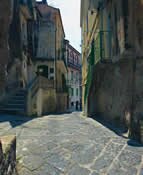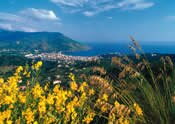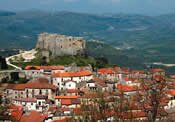Inflight Magazine of Brussels Airlines
Welcome to the Inflight Magazine of Brussels Airlines
Coast with the most
Josephine Quintero escapes the summer throngs and designer thongs of Capri and the Amalfito discover the unsung glories, unspoiled beaches and rural beauty of the coast’s southerly neighbour, Cilento
Image photolibrary.com, Alamy, 4Corners
 Head south around 49km from Salerno on the AmalfiCoast and you reach the Cilento National Park, a compelling combination of dense woods, dramatic mountains, flowering meadows and water – lots of it – with rivers, streams and waterfalls. It’s the second largest national park in Italy, and a World Heritage site, yet – aside from Italians in the know (and me) – most people have never heard of the place. Or if you prefer a sun bed on the sand, Cilento can also oblige, flanking its coast with long sweeps of beach, secluded coves and low-key resorts – as well as considerably undercutting Capri in the affordable ice creams and Campari stakes.
Head south around 49km from Salerno on the AmalfiCoast and you reach the Cilento National Park, a compelling combination of dense woods, dramatic mountains, flowering meadows and water – lots of it – with rivers, streams and waterfalls. It’s the second largest national park in Italy, and a World Heritage site, yet – aside from Italians in the know (and me) – most people have never heard of the place. Or if you prefer a sun bed on the sand, Cilento can also oblige, flanking its coast with long sweeps of beach, secluded coves and low-key resorts – as well as considerably undercutting Capri in the affordable ice creams and Campari stakes.
Northern star
The northernmost Cilento resort is the roll-off-the-tongue town of Agropoli. An excellent base for exploring both coast and park, it’s a bustling, typically Italian place with a refreshing lack of coach tours, despite being surrounded by pristine sandy beaches. After building your sandcastle and burning your nose, dip into the historic centre: a fascinating tangle of shady cobbled streets offering a castle in good nick as well as ancient churches, idiosyncratic shops and superb spaghetti a vongole (with clams) at classic trattoria U’Sghiz on Piazza Umberto I. Jovial owner Antonio has a few good rooms for rent here, too.
Around 14km south of Agropoli is Santa Maria di Castellabate, which is a personal Cilento favourite. This former fishing village has that palatable southern-Italian feel, with sun bleached pink-and-ochre houses blinkered by traditional green shutters and strung with washing – Italians love to show off their colour-coordinated laundry.
And there’s more beach, of course: you can enjoy 3.7km of sand between your toes, nudging the turquoise blue waters of the Tyrrhenian Sea.
 Medieval marvel
Medieval marvel
Just inland from its coastal sidekick is the movie-set magic of the crumbling medieval village Castellabate. True, there are a few more visitors here at this time of year, but they’re mainly Italian and so blend in better than pale northern Europeans in shorts. Impressive from afar, the village is topped by a castle like a cherry on a cake and still partially circled by its 12th-century defensive walls. Castellabate has the typical labyrinthine cobbled streets, punctuated by tiny piazzas and the occasional palazzo. Come here on a sultry evening and sip an aperitivo while watching that superbly civilised Italian tradition, the passeggiata (evening stroll).
Ernest Hemingway had a penchant for finding the choice spots in the world, so naturally he spent time in this region. His favourite town was Acciaroli, just south of Santa Maria, which has been fashionably restored using local stone and traditional architecture. Although still nowhere near the hedonistic heights of Amalfi, you will spot the occasional Gucci bag here, as well as upper-crust pizzerias and smart restaurants with black bow-tied waiters.
 Gourmets should also note that the Cilento region is home to mozzarella cheese – the flavourful creamy original, which is as far removed from those insipid watery balls you find in some supermarkets as a dairy buffalo is from a Welsh sheep. Look for it on local menus during your travels, or visit a mozzarella farm for a tour and tasting. One of the best is the organic buffalo farm Vannulo (www.vannulo.it) in Capaccio Scalo; if you’re a serious formaggi fan, there’s also accommodation on offer.
Gourmets should also note that the Cilento region is home to mozzarella cheese – the flavourful creamy original, which is as far removed from those insipid watery balls you find in some supermarkets as a dairy buffalo is from a Welsh sheep. Look for it on local menus during your travels, or visit a mozzarella farm for a tour and tasting. One of the best is the organic buffalo farm Vannulo (www.vannulo.it) in Capaccio Scalo; if you’re a serious formaggi fan, there’s also accommodation on offer.
The Cilento’s tiara of coastal delights continues southwards until it reaches the westernmost town of Sapri, while en route you’ll pass such gems as Pioppi, Marina di Casal Velino and Palinuro.
The latter is famed for its extraordinary blue grotto, not unlike its Capri counterpart – but without the hype.
 Time-warp towns
Time-warp towns
Head inland from the coast and you come to Cilento’s wonderful untamed natural park. Out of the tourism loop for decades and yet inhabited since prehistoric times, the villages have a tangible stuck-in-time feel (be prepared for stares). The region is increasingly popular with walkers, too, and agriturismi (farm accommodation) make perfect bases. They can also advise on activities, including horse riding and hiking trails; check the www.campaniaagrituristica.it website for suggestions.
The park is home to some lovely villages, complete with castles, churches and historic convents. Sicignano degli Alburni, Castelcivita, Petina, Postiglione and stunning Teggiano all come highly recommended, the latter bristling with churches and museums as well as a cathedral and a castle. Stay overnight at a former palace, Antichi Feudi (www.antichifeudi.com), just off the main piazza, or simply lunch on this establishment’s simple yet delicious speciality of grilled swordfish.
 The region also features some cultural big hitters, including one of the largest monasteries in southern Europe. The Certosa di San Lorenzo in tiny Padula dates from 1306 and is a tad larger than your average family home – covering a massive 250,000m2. With 320 rooms and 2,500m of corridors, it’s pretty important that you allocate your time with care; I particularly fancied the frescoed chapels and wood-panelled library, with its wonderful earthy smell of old books. The kitchen is another must-see, with its enormous fireplace; apparently this is where the legendary 1,000 egg omelette was made in 1534 for Charles V. Unfortunately, the frying pan isn’t on view – it must have been the size of a small roller-skating rink…
The region also features some cultural big hitters, including one of the largest monasteries in southern Europe. The Certosa di San Lorenzo in tiny Padula dates from 1306 and is a tad larger than your average family home – covering a massive 250,000m2. With 320 rooms and 2,500m of corridors, it’s pretty important that you allocate your time with care; I particularly fancied the frescoed chapels and wood-panelled library, with its wonderful earthy smell of old books. The kitchen is another must-see, with its enormous fireplace; apparently this is where the legendary 1,000 egg omelette was made in 1534 for Charles V. Unfortunately, the frying pan isn’t on view – it must have been the size of a small roller-skating rink…
Lunar landscapes
 If you find this lavishness a little vulgar, the park is also home to somewhere altogether more natural but no less visually stunning. The underground cave at Castelcivita (www.grottedicastelcivita.it) was inhabited 42,000 years ago, rating it the oldest settlement in Europe. It’s appropriately otherworldly – a lunar landscape with sculpted rock shapes and stalactites and stalagmites. The second cave in the park, at Pertosa, dates back 35 million years. The first part of the tour here involves a boat ride into the cave, adding to the feel of adventure.
If you find this lavishness a little vulgar, the park is also home to somewhere altogether more natural but no less visually stunning. The underground cave at Castelcivita (www.grottedicastelcivita.it) was inhabited 42,000 years ago, rating it the oldest settlement in Europe. It’s appropriately otherworldly – a lunar landscape with sculpted rock shapes and stalactites and stalagmites. The second cave in the park, at Pertosa, dates back 35 million years. The first part of the tour here involves a boat ride into the cave, adding to the feel of adventure.
This vast and diverse corner of Italy is easily accessible, located just 80km from Naples airport. Visit the Cilento once and, believe me, you will be back.
FR Cilento, si beau
Josephine Quintero a fui la cohue estivale de Capri et de la côte amalfitaine, pour partir à la découverte des splendeurs méconnues du Cilento, son voisin du sud
Mettez le cap au sud, à 49 km de Salerne sur la côte amalfitaine, et vous arrivez au Parc national du Cilento. C’est le second parc d’Italie en taille, et pourtant la plupart des gens n’en ont jamais entendu parler. Et si vous préférez le farniente, les longues plages du Cilento et ses petites stations balnéaires tranquilles devraient aussi vous combler.
La station balnéaire la plus au nord du Cilento est Agropoli, un excellent point de départ pour découvrir tant la côte que le parc, loin des cars touristiques. Partez à la rencontre de ses rues pavées, de son château et de ses vieilles églises, avant de dévorer un spaghetti a vongole à la trattoria U’Sghiz sur la Piazza Umberto I. A peu près 14 km plus au sud se trouve Santa Maria di Castellabate, un adorable ancien village de pêcheurs, avec, à l’intérieur des terres, le décor magique des ruines du Castellabate médiéval. Venez, dans la chaleur d’un soir d’été, y siroter un aperitivo tout en regardant la passeggiata (promenade). Acciaroli, juste au sud de Santa María, était l’endroit favori d’Ernest Hemingway dans le Cilento. Restauré et en vogue, le village exhibe aujourd’hui fièrement ses pizzerias haut-de-gamme et ses restaurants chics. Les gourmets retiendront également que la région est la patrie de la mozzarella – on peut d’ailleurs y visiter une ferme, dégustations comprises, comme par exemple Vannulo (vannulo.it) à Capaccio Scalo.
En se dirigeant vers l’intérieur du pays, on arrive au parc. Loin des circuits touristiques et cependant habitée depuis la préhistoire, c’est une région en plein essor pour les amateurs de promenades, et l’Agriturismi (logement à la ferme) y constitue un ancrage parfait (campaniaagrituristica.it). Le parc abrite également plusieurs villages préservés, avec leur château, leurs églises et couvents historiques – Sicignano degli Alburni, Castelcivita et Teggiano sont à découvrir absolument. Et au niveau culturel, ne manquez pas l’un des plus grands monastères de l’Europe du sud – la Certosa di San Lorenzo à Padula – et les grottes antiques du parc à Castelcivita (grottedicastelcivita.it) et Pertosa.
D’une incroyable variété, ce petit coin d’Italie est facilement accessible; y aller une fois, c’est s’assurer d’y revenir.
NL Ontdek de mooiste kusten
Josephine Quintero vlucht weg van de zomerdrukte in Capri en Amalfi en ontdekt de nog onvolprezen topplekjes van zuiderbuur Cilento
Zo’n 49 km ten zuiden van Salerno langsheen de kust van Amalfi bevindt zich het Nationale Park van Ciolento. Het park is het op een na grootste van Italië, hoewel de meesten er nog nooit van gehoord hebben. Ga je voor een zonnebeurt? De lange stranden van Cilento en de rustige dorpjes zijn uiterst aanlokkelijk.
Agropoli is het meest noordelijk gelegen plaatsje van Cilento, de ideale uitvalsbasis voor een bezoekje aan het strand en het park waar je maar weinig toeristische bussen vindt. Bijzonder aangenaam! Ontdek de met kinderkopjes aangelegde straten, het kasteel en oude kerkjes en geniet van een spaghetti a vongole in trattoria U’Sghiz op Piazza Umberto I. Ongeveer 14 km zuidwaarts bevindt zich Santa Maria di Castellabate, een betoverend voormalig vissersdorpje en even landinwaarts ontdek je de overblijfselen van het middeleeuwse Castellabate, dat zo dienst zou kunnen doen als filmlocatie. Nip tijdens een zwoele avond van een aperitivo en geniet van de voorbijgangers passeggiata. Acciaroli, even ten zuiden van Santa Maria, was de favoriete plek in Cilento van Ernest Hemingway. Hier werd alles stijlvol heropgebouwd en vind je talrijke pizzeria’s en snackbars. Weetje voor de fijnproevers: deze streek staat bekend voor zijn mozzarella kaas. In Capaccio Scalo kan je boerderijen zoals Vannulo (vannulo.it) bezoeken voor een begeleid bezoek en een proeverij.
Ga landinwaarts en je ontdekt het Nationale Park. Dit gebied, nog onontdekt door toeristen en toch al sinds eeuwen bewoond, is een geliefde plek voor wandelaars en leent zich perfect voor Agriturismi (boerderijtoerisme). Het park huist eveneens onbevlekte dorpjes met kastelen, kerkjes en historische kloosters – Sicignano degli Alburni, Castelcivita en Teggiano zijn echte aanraders. Cultuurliefhebbers moeten in Padula zeker een bezoekje brengen aan Certosa di San Lorenzo, een van Zuid-Europa’s grootste kloosters, aan de oude grotten van het park in Castelcivita (grottedicastelcivita.it) en aan Pertosa.
Deze bijzonder diverse uithoek van Italië is gemakkelijk bereikbaar. Bezoek het en je keert ongetwijfeld terug!
Leave a Reply
